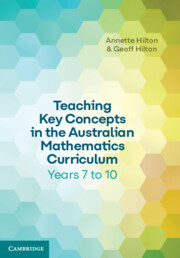Refine search
Actions for selected content:
48533 results in Computer Science
Chapter 6 - Measurement
-
- Book:
- Teaching Key Concepts in the Australian Mathematics Curriculum Years 7 to 10
- Published online:
- 13 August 2025
- Print publication:
- 21 August 2025, pp 158-191
-
- Chapter
- Export citation
Introduction
-
- Book:
- Lost in Automatic Translation
- Published online:
- 08 October 2025
- Print publication:
- 21 August 2025, pp 1-2
-
- Chapter
- Export citation
Copyright page
-
- Book:
- Teaching Key Concepts in the Australian Mathematics Curriculum Years 7 to 10
- Published online:
- 13 August 2025
- Print publication:
- 21 August 2025, pp iv-iv
-
- Chapter
- Export citation
Acknowledgments
-
- Book:
- Lost in Automatic Translation
- Published online:
- 08 October 2025
- Print publication:
- 21 August 2025, pp xi-xii
-
- Chapter
- Export citation
Part I - Communicating in English
-
- Book:
- Lost in Automatic Translation
- Published online:
- 08 October 2025
- Print publication:
- 21 August 2025, pp 3-36
-
- Chapter
- Export citation
Chapter 2 - The principles of mathematics education
-
- Book:
- Teaching Key Concepts in the Australian Mathematics Curriculum Years 7 to 10
- Published online:
- 13 August 2025
- Print publication:
- 21 August 2025, pp 20-42
-
- Chapter
- Export citation
Chapter 7 - Internet Speak Is the Best, Don’t @ Me
- from Part II - Understanding Cultural Norms and References
-
- Book:
- Lost in Automatic Translation
- Published online:
- 08 October 2025
- Print publication:
- 21 August 2025, pp 115-136
-
- Chapter
- Export citation

The AI and Data Revolution
- Understanding the New Data Landscape
-
- Published by:
- Facet
- Published online:
- 20 August 2025
- Print publication:
- 24 April 2025
On approximability of satisfiable
 $\boldsymbol {k}$-CSPs: II
$\boldsymbol {k}$-CSPs: II
-
- Journal:
- Combinatorics, Probability and Computing , First View
- Published online by Cambridge University Press:
- 20 August 2025, pp. 1-70
-
- Article
-
- You have access
- HTML
- Export citation
Comparing TRIZ and brainstorming in human–agent design collaboration: effects on cognitive processes and performance
-
- Article
-
- You have access
- Open access
- HTML
- Export citation
Integrating Belief Domains into Probabilistic Logic Programs
-
- Journal:
- Theory and Practice of Logic Programming / Volume 25 / Issue 4 / July 2025
- Published online by Cambridge University Press:
- 20 August 2025, pp. 455-472
-
- Article
-
- You have access
- Open access
- HTML
- Export citation
ABSTRACTION PRINCIPLES AND THE SIZE OF REALITY
- Part of
-
- Journal:
- The Review of Symbolic Logic / Volume 18 / Issue 3 / September 2025
- Published online by Cambridge University Press:
- 19 August 2025, pp. 812-825
- Print publication:
- September 2025
-
- Article
- Export citation
Impact and Performance of Randomized Test Generation Using Prolog
-
- Journal:
- Theory and Practice of Logic Programming , First View
- Published online by Cambridge University Press:
- 18 August 2025, pp. 1-29
-
- Article
-
- You have access
- Open access
- HTML
- Export citation
Parallel dual-numbers reverse AD
- Part of
-
- Journal:
- Journal of Functional Programming / Volume 35 / 2025
- Published online by Cambridge University Press:
- 15 August 2025, e16
-
- Article
-
- You have access
- Open access
- HTML
- Export citation
An empirical investigation of value-based multi-objective reinforcement learning for stochastic environments
-
- Journal:
- The Knowledge Engineering Review / Volume 40 / 2025
- Published online by Cambridge University Press:
- 15 August 2025, e6
-
- Article
-
- You have access
- Open access
- HTML
- Export citation
OpenLimbTT, a transtibial residual limb shape model for prosthetics simulation and design: creating a statistical anatomic model using sparse data
-
- Journal:
- Data-Centric Engineering / Volume 6 / 2025
- Published online by Cambridge University Press:
- 15 August 2025, e39
-
- Article
-
- You have access
- Open access
- HTML
- Export citation
Inductive synthesis of structurally recursive functional programs from non-recursive expressions
- Part of
-
- Journal:
- Journal of Functional Programming / Volume 35 / 2025
- Published online by Cambridge University Press:
- 15 August 2025, e17
-
- Article
-
- You have access
- Open access
- HTML
- Export citation

Teaching Key Concepts in the Australian Mathematics Curriculum Years 7 to 10
-
- Published online:
- 13 August 2025
- Print publication:
- 21 August 2025
-
- Textbook
- Export citation
A short proof of the Frobenius property for generic fibrations
-
- Journal:
- Mathematical Structures in Computer Science / Volume 35 / 2025
- Published online by Cambridge University Press:
- 13 August 2025, e20
-
- Article
-
- You have access
- Open access
- HTML
- Export citation















































